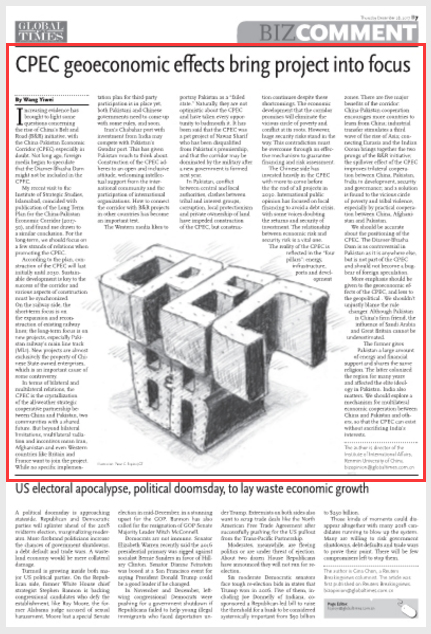Major Power Relations
Your Present Location: PROGRAMS> Major Power RelationsWang Yiwei: CPEC geoeconomic effects bring project into focus
By Wang Yiwei Source: Global Times Published: 2017-12-27
Increasing evidence has brought to light some questions concerning the rise of China`s Belt and Road (B&R) initiative, with the China-Pakistan Economic Corridor (CPEC) especially in doubt. Not long ago, foreign media began to speculate that the Diamer-Bhasha Dam might not be included in the CPEC.

My recent visit to the Institute of Strategic Studies, Islamabad, coincided with publication of the Long Term Plan for the China-Pakistan Economic Corridor (2017-30), and found me drawn to a similar conclusion. For the long-term, we should focus on a few strands of relations when promoting the CPEC.
According to the plan, construction of the CPEC will last initially until 2030. Sustainable development is key to the success of the corridor and various aspects of construction must be synchronized. On the railway side, the short-term focus is on the expansion and reconstruction of existing railway lines; the long-term focus is on new projects, especially Pakistan railway`s main line track (ML1). New projects are almost exclusively the property of Chinese State-owned enterprises, which is an important cause of some controversy.
In terms of bilateral and multilateral relations, the CPEC is the crystallization of the all-weather strategic cooperative partnership between China and Pakistan, two communities with a shared future. But beyond bilateral limitations, multilateral radiation and incentives mean Iran, Afghanistan and even Western countries like Britain and France want to join the project. While no specific implementation plan for third-party participation is in place yet, both Pakistani and Chinese governments need to come up with some rules, and soon.
Iran`s Chabahar port with investment from India may compete with Pakistan`s Gwadar port. This has given Pakistan much to think about. Construction of the CPEC adheres to an open and inclusive attitude, welcoming intellectual support from the international community and the participation of international organizations. How to connect the corridor with B&R projects in other countries has become an important test.
The Western media likes to portray Pakistan as a "failed state." Naturally, they are not optimistic about the CPEC and have taken every opportunity to badmouth it. It has been said that the CPEC was a pet project of Nawaz Sharif who has been disqualified from Pakistan`s premiership, and that the corridor may be dominated by the military after a new government is formed next year.
In Pakistan, conflict between central and local authorities, clashes between tribal and interest groups, corruption, local protectionism and private ownership of land have impeded construction of the CPEC, but construction continues despite these shortcomings. The economic development that the corridor promises will eliminate the vicious circle of poverty and conflict at its roots. However, huge security risks stand in the way. This contradiction must be overcome through an effective mechanism to guarantee financing and risk assessment.
The Chinese side has invested heavily in the CPEC with more to come before the the end of all projects in 2030. International public opinion has focused on local financing to avoid a debt crisis, with some voices doubting the returns and security of investment. The relationship between economic risk and security risk is a vital one.
The reality of the CPEC is reflected in the "four pillars": energy, infrastructure, ports and development zones. There are five major benefits of the corridor: China-Pakistan cooperation encourages more countries to learn from China; industrial transfer stimulates a third wave of the rise of Asia; connecting Eurasia and the Indian Ocean brings together the two prongs of the B&R initiative; the spillover effect of the CPEC improves trilateral cooperation between China, Pakistan, India in development, security and governance; and a solution is found to the vicious circle of poverty and tribal violence, especially by practical cooperation between China, Afghanistan and Pakistan.
We should be accurate about the positioning of the CPEC. The Diamer-Bhasha Dam is as controversial in Pakistan as it is anywhere else, but is not part of the CPEC and should not become a bugbear of foreign speculation.
More emphasis should be given to the geoeconomic effects of the CPEC, and less to the geopolitical . We shouldn`t unjustly blame the rule changer. Although Pakistan is China`s firm friend, the influence of Saudi Arabia and Great Britain cannot be underestimated.
The former gives Pakistan a large amount of energy and financial support and shares the same religion. The latter colonized the region for many years and affected the elite ideology in Pakistan. India also matters. We should explore a mechanism for multilateral economic cooperation between China and Pakistan and others, so that the CPEC can exist without sacrificing India`s interests.
The author is a senior fellow of Chongyang Institute for Financial Studies, Renmin University of China.
Key Words: CPEC; Belt and Road; RDCY; Wang Yiwei























































































 京公网安备 11010802037854号
京公网安备 11010802037854号





